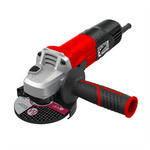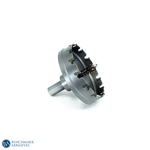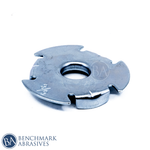
Wet Sanding Vs Dry Sanding - Quick Comparison

Sanding is a crucial step in the surface preparation and finishing process. The selection of sanding techniques substantially affects the result, whether you're smoothing wood, polishing car paint, or preparing metal for a coating.
Wet sanding and dry sanding are the two primary methods used in this procedure. Both dry and wet sanding rely on abrasive materials such as sandpaper to smooth surfaces and correct imperfections. The primary distinction is that wet sanding is lubricated with water. This single difference significantly affects the sanding process, resulting in distinct benefits, drawbacks, and ideal applications for each technique.
This blog will guide you about wet sanding and dry sanding, its applications, and its benefits and drawbacks.
What is Wet Sanding?
Wet sanding is a type of sanding that uses mainly water as a liquid lubricant, occasionally with a small amount of soap added to it during the sanding process. When compared to dry sanding, wet sanding involves continuously moistening the surface being worked on as well as the sandpaper. This helps the abrasive particles to run more smoothly over the surface, resulting in a reduction in the chances of deep, noticeable scratches and generating a fine and smooth finish.
Wet sanding is mainly used for getting an extremely smooth, fine finish. It is primarily used in the last stages of sanding, particularly for high-end furniture, automotive paint, and some woodworking finishes. Additionally, the wet surface can serve as a visual help, drawing attention to any residual errors that could be harder to see when dry, enabling more focused and accurate refining.
Pros Of Wet Sanding
The following are the pros of wet sanding:
- Less dust: The water used in the process of sanding traps the dust particles and prevents them from flying in the air, keeping your workspace clean and healthy.
- Smoother Finish: The water acts as a lubricant that helps the abrasive move more smoothly and reduces the risk of deep scratches on the surface. In addition, it helps in eliminating swarf or removed material, preventing the sandpaper from getting clogged.
- Cooler surface: The water used in the process of sanding is capable of dissipating heat produced by friction while sanding for long hours or on soft materials. It helps in preventing damage.
- Exposes Imperfections: When the surface is wet, it may be easier to spot flaws that might otherwise go unnoticed.
Cons Of Wet Sanding
The following are the cons of wet sanding:
- Messy process: Wet sanding can be a messy process due to the buildup of slurry (a mix of water and the removed material). To ensure a smooth process, frequently clean the slurry between the processes.
- Slow material removal: Wet sanding eliminates material slowly when compared to dry sanding since the water absorbs the abrasive action.
- No one-size-fits-all solution: Wet sanding is not suitable for all materials, especially certain types of wood that may absorb water or swell. Likewise, it is not recommended for metals that are prone to rust.
- Use waterproof abrasives: Ensure to use sandpaper that is only made for wet sanding and has a waterproof backing and abrasive.
- Drying time: it requires time to dry the sanded surface before further finishing.
What is Dry Sanding?
Dry sanding is the conventional and most popular method of smoothing surfaces by using abrasive materials like sandpaper without using any liquid lubricant or water. In this process, the sandpaper is directly used on the dry surface, eliminating material and smoothing out the surface. When compared to wet sanding, dry sanding usually provides an aggressive material removal rate, which makes it perfect for projects requiring quick stock removal.
Dry sanding is a versatile technique used for a wide range of tasks. It's ideal for aggressive jobs like initial shaping and bulk material removal, as well as for finer work like preparing a surface for a final finish. You'll find it widely used across many fields, from metalworking and woodworking to countless DIY projects.
Pros Of Dry Sanding
The advantages of dry sanding are:
- Quick material removal: due to its aggressive cutting nature, it removes material quickly and efficiently.
- Easy to use: dry sanders are easy to clean and handle and require minimal setup.
- Versatile: Dry sanders are suitable for a wider variety of materials, especially water-sensitive materials.
- No drying time required: there is no need to dry the surface; you can immediately proceed with the next step.
Cons Of Dry Sanding
The disadvantages of dry sanding are:
- Dust Generation: Dry sanding generates a large amount of dust, which can settle on the workpiece, resulting in an uneven finish, and it also affects your health. Therefore, it is preferable to use appropriate safety gear or respirators.
- Risk of clogging: Sanding with too much dust or removing too much material can quickly clog up your sandpaper.
- Heat Buildup: Dry sanding can create a lot of friction, which results in heat buildup and might damage the material or lead to uneven sanding.
- Less smooth finish: Dry sanding, when used with finer grits, leads to more scratches when compared to wet sanding.
When to Use: Wet Sanding or Dry Sanding
Use wet sanding when:
- Dust control is essential
- You require an excessively smooth, high-quality finish
- Dealing with very fine grits of sandpaper
- Sanding materials that can deal with moisture
- When working with clear coats or paint, particularly for furniture or vehicles
Use Dry sanding when:
- Rapid removal of material
- Dealing with water-sensitive materials, including hardwoods or metals that easily rust.
- To shape and level the surface at the initial stages
- Where speed and convenience are essential
The Future of Sanding: Automated and Smart Solutions
The sanding industry is rapidly adopting automation and smart solutions to increase efficiency, consistency, and worker safety. Automated sanding systems reduce human error and fatigue by using robotics and advanced sensors, including improved dust extraction and precise water control for wet sanding. Additionally, innovative sanding equipment provides real-time feedback on surface roughness and wear due to friction, thereby improving material removal and extending the life of sandpaper.
Despite the high initial investment, long-term benefits such as improved quality, reduced labor costs, improved safety, and faster project completion are driving the implementation of these technologies across various industries, transforming the sanding process into a more controlled and efficient operation.
Conclusion
Both wet and dry sanding methods are applied at various stages in numerous projects. To get a smooth finish, you can use wet sanding with finer grits after beginning with dry sanding for quick material removal.



































































